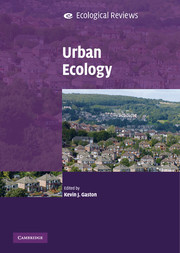Book contents
- Frontmatter
- Contents
- List of contributors
- Preface
- 1 Urban ecology
- 2 Urbanisation
- 3 Urban environments and ecosystem functions
- 4 Individual species and urbanisation
- 5 Species diversity and urbanisation: patterns, drivers and implications
- 6 Urbanisation and alien invasion
- 7 Interactions between people and nature in urban environments
- 8 Urban ecology and human social organisation
- 9 Urban ecology and human health and wellbeing
- 10 Bringing cities alive: the importance of urban green spaces for people and biodiversity
- 11 Integrating nature values in urban planning and design
- 12 Urban futures
- Index
- References
1 - Urban ecology
Published online by Cambridge University Press: 05 June 2012
- Frontmatter
- Contents
- List of contributors
- Preface
- 1 Urban ecology
- 2 Urbanisation
- 3 Urban environments and ecosystem functions
- 4 Individual species and urbanisation
- 5 Species diversity and urbanisation: patterns, drivers and implications
- 6 Urbanisation and alien invasion
- 7 Interactions between people and nature in urban environments
- 8 Urban ecology and human social organisation
- 9 Urban ecology and human health and wellbeing
- 10 Bringing cities alive: the importance of urban green spaces for people and biodiversity
- 11 Integrating nature values in urban planning and design
- 12 Urban futures
- Index
- References
Summary
What is urban ecology?
Real ecologists study wild and natural places. At least, that has been the view which has dominated the field of ecology for much of its existence. Some lone voices argued that this was a narrow, unrealistic and unhelpful perspective, but their arguments were easily ignored by the majority as they focused on their supposedly pristine field sites. This was always something of an irony, as surely there was never any real doubt that less wild and natural areas equally functioned as ecosystems, containing the same essential components (e.g. water, soil, microorganisms, plants, animals), and being subject to much the same processes (e.g. carbon, nutrient and water cycles). Thus, towards the close of the twentieth century and the dawning of the twenty-first, this viewpoint changed radically. Growing numbers of studies focused on the patterns and processes structuring systems that had been heavily modified, or were essentially created, by human activities. This change was particularly evident with respect to the ecology of urban areas, with numerous research studies, commentaries and reviews being published (e.g. Gilbert 1989; McDonnell & Pickett 1993; Grimm et al. 2000, 2008a, 2008b; Marzluff et al. 2001, 2008; Pickett et al. 2001; Kelcey & Rheinwald 2005; Forman 2008). Indeed, not only did ecologists begin to study urban systems in earnest, but urban ecology also began to influence the study of ecology more widely. In short, urban ecology came of age.
- Type
- Chapter
- Information
- Urban Ecology , pp. 1 - 9Publisher: Cambridge University PressPrint publication year: 2010
References
- 11
- Cited by



